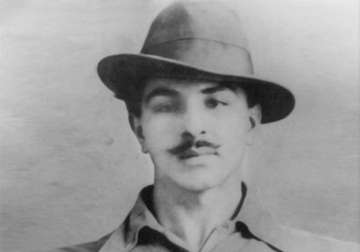New Delhi: Today is the 108th birth anniversary of India's greatest revolutionary freedom fighter Bhagat Singh.
Bhagat Singh was born into a Punjabi Sikh family which had earlier been involved in revolutionary activities against the British rule.
The British rulers in India were afraid of the rising popularity of Bhagat Singh and his ways of exploiting the government machinery, the courts and newspapers for propagating his ideology.
He is commemorated with a range of memorials including a large bronze statue in the Parliament of India.
India TV brings to you 10 facts about the brave freedom fighter:
1. Unlike many Sikhs of his age, Bhagat did not attend the Khalsa High School in Lahore. His grandfather did not approve of the school officials' loyalism to the British government and so Bhagat was enrolled in the Dayanand Anglo-Vedic High School, an Arya Samaji institution.
2. In 1919, when he was 12 years old, Bhagat visited the site of the Jallianwala Bagh massacre hours after thousands of unarmed people gathered at a public meeting had been killed. He became disillusioned with Mahatma Gandhi's philosophy of non-violence after latter called off the non-cooperation movement. It was only then, Bhagat joined the Young Revolutionary Movement and began to advocate for the violent overthrow of the British Government in India.
3. In 1927, Bhagat Singh left home for Kanpur when his parents tried to get him married. In a letter he left behind, he said: My life has been dedicated to the noblest cause, that of the freedom of the country. Therefore, there is no rest or worldly desire that can lure me now.
4. A Sikh by birth, he shaved his beard and cut his hair to avoid being recognised and arrested by Britishers. He managed to escape from Lahore to Calcutta (now Kolkata) after killing Assistant Superintendent of Police John Saunders.
5. He along with Sukhdev had planned to avenge the death of Lala Lajpat Rai and plotted to kill the Superintendent of Police James Scott in Lahore. But they failed to identify Scott and killed Saunders.
6. A year later, he and Batukeshwar Dutt threw bombs in the Central Assembly Hall in Delhi, and shouted 'Inquilab Zindabad'. He did not resist his arrest.
7. During his stay in jail, he aggressively propagated the idea of India's freedom. He went on 116-day hunger strike to protest discrimination in treatment with prisoners of India and foreigners.
8. Bhagat Singh marched to the gallows with a smile on his face and his one last act of defiance was shouting 'Down with British imperialism'.
9. His death sentence was pronounced on October 7, 1930. He heard his punishment with defiant courage. He was slated to be hanged on March 24, 1931, but Britishers pre-pond his hanging and executed him on March 23 morning at 7:30 pm. He was just 23 years old when he was hanged.
10. Bhagat's execution was reported widely by the press, especially as they were on the eve of the annual convention of the Congress party at Karachi. Mahatma Gandhi faced black flag demonstrations by angry youths who shouted 'Down with Gandhi'.
Latest India News
